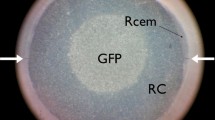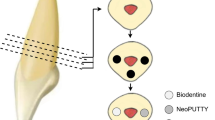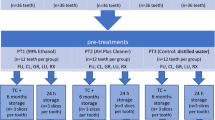Abstract
Objectives
This study aims to investigate the effects of calcium hydroxide (Ca(OH)2) dressing in root canals and the effects of subsequent acid etching on the adhesion of luting resins to root canals.
Materials and methods
Root specimens were prepared from extracted human permanent molars. Specimen canals were (1) filled with etch-and-rinse (Nexus® third generation (NX3)) and two self-adhesive (RelyX Unicem, Maxcem Elite) luting resins, respectively; (2) dressed with Ca(OH)2 before Ca(OH)2 removal and luting resin filling; (3) dressed with Ca(OH)2 before Ca(OH)2 removal and post-cementation; or (4) treated as described in item (2) except that the canals were further etched with phosphoric acid before luting resin filling. Push-out bond strengths were measured and analyzed using one-way analysis of variance, and Fisher’s multiple comparison tests provided a follow-up comparison among these four canal treatments. Attenuated total reflectance-Fourier transform infrared spectroscopy, X-ray photoelectron spectroscopy (XPS), and scanning electron microscopy (SEM) were used to analyze the specimen surfaces.
Results
Ca(OH)2 dressing adversely affected the bond strengths to canal dentin of the three luting resins tested. Acid etching did not increase the bond strengths. Infrared analysis revealed that Ca(OH)2 dressing caused no structural changes on the dentin surface. XPS and SEM analyses revealed Ca(OH)2 remnants as the ultimate chemical cause leading to the decrease in bond strength.
Conclusions
The bond strength of luting resin to dentin was affected by Ca(OH)2 dressing. Acid etching treatment could not increase the bond strength.
Clinical relevance
Adhesion of the fiber post to the root canal wall may be compromised after Ca(OH)2 dressing. An effective method for complete removal of Ca(OH)2 dressing or increase of bond strength for luting resin needs to be developed.





Similar content being viewed by others
References
Boone KJ, Murchison DF, Schindler WG, Walker WA (2001) Post retention: the effect of post-space preparation, cementation time, and different sealers. J Endod 27:768–771
Schwartz RS, Robbins JW (2004) Post placement and restoration of endodontically treated teeth: a literature review. J Endod 30:289–301
Aksornmuang J, Nakajima M, Foxton RM, Tagami J (2007) Mechanical properties and bond strength of dual-cure resin composites to root canal dentin. Dent Mater 23:226–234
Cheung W (2005) A review of the management of endodontically treated teeth. J Am Dent Assoc 136:611–619
Radovic I, Monticelli F, Goracci C, Vulicevic ZR, Ferrari M (2008) Self-adhesive resin cements: a literature review. J Adhes Dent 10:251–258
Breschi L, Mazzoni A, Ruggeri A, Cadenaro M, Di Lenarda R, De Stefano DE (2008) Dental adhesion review: aging and stability of the bonded interface. Dent Mater 24:90–101
Gerth HUV, Dammaschke T, Züchner H, Schäfer E (2006) Chemical analysis and bonding reaction of RelyX Unicem and Bifix composites—a comparative study. Dent Mater 22:934–941
Zhang L, Huang L, Xiong Y, Fang M, Chen JH, Ferrari M (2008) Effect of post-space treatment on retention of fiber posts in different root regions using two self-etching systems. Eur J Oral Sci 116:280–286
Schwartz RS (2006) Adhesive dentistry and endodontics. Part 2: bonding in the root canal system—the promise and the problems: a review. J Endod 32:1125–1134
Mjör IA, Smith MR, Ferrari M, Mannocci F (2001) The structure of dentine in the apical region of human teeth. Int Endod J 34:346–353
Tay FR, Loushine RJ, Lambrechts P, Weller RN, Pashley DH (2005) Geometric factors affecting dentin bonding in root canals: a theoretical modeling approach. J Endod 31:584–589
Balvedi RPA, Versiani MA, Manna FF, Biffi JCG (2010) A comparison of two techniques for the removal of calcium hydroxide from root canals. Int Endod J 43:763–768
Teixeira CS, Pasternak-Junior B, Borges AH, Paulino SM, Sousa-Neto MD (2008) Influence of endodontic sealers on the bond strength of carbon fiber posts. J Biomed Mater Res B Appl Biomater 84:430–435
Ari H, Yaşar E, Belli S (2003) Effects of NaOCl on bond strengths of resin cements to root canal dentin. J Endod 29:248–251
Paul SJ, Schärer P (1997) Effect of provisional cements on the bond strength of various adhesive bonding systems on dentine. J Oral Rehabil 24:8–14
Lee BS, Lai EH, Liao KH, Lee CY, Hsieh KH, Lin CP (2008) A novel polyurethane-based root canal-obturation material and urethane-acrylate-based root canal sealer-part 2: evaluation of push-out bond strengths. J Endod 34:594–598
Kang BS, Sul YT, Jeong Y, Byon E, Kim JK, Cho S, Oh SJ, Albrektsson T (2011) Metal plasma immersion ion implantation and deposition (MePIIID) on screw-shaped titanium implant: the effects of ion source, ion dose and acceleration voltage on surface chemistry and morphology. Med Eng Phys 33:730–738
Kang BS, Sul YT, Johansson CB, Oh SJ, Lee HJ, Albrektsson T (2012) The effect of calcium ion concentration on the bone response to oxidized titanium implants. Clin Oral Implants Res 23:690–697
Lin CP, Lee BS, Lin FH, Kok SH, Lan WH (2001) Phase, compositional, and morphological changes of human dentin after Nd:YAG laser treatment. J Endod 27:389–393
Cai Y, Zhang S, Zeng X, Qian M, Sun D, Weng W (2011) Interfacial study of magnesium-containing fluoridated hydroxyapatite coatings. Thin Solid Films 519:4629–4933
Boyd A, Akay M, Meenan BJ (2003) Influence of target surface degradation on the properties of r.f. magnetron-sputtered calcium phosphate coatings. Surf Interface Anal 35:188–198
Chusuei CC, Goodman DW, Van Stipdonk MJ, Justes DR, Schweikert EA (1999) Calcium phosphate phase identification using XPS and time-of-flight cluster SIMS. Anal Chem 71:149–153
Siqueira JF, Lopes HP (1999) Mechanisms of antimicrobial activity of calcium hydroxide: a critical review. Int Endod J 32:361–369
Kim SK, Kim YO (2002) Influence of calcium hydroxide intracanal medication on apical seal. Int Endod J 35:623–628
Rödig T, Vogel S, Zapf A, Hülsmann M (2010) Efficacy of different irrigants in the removal of calcium hydroxide from root canals. Int Endod J 43:519–527
Nandini S, Velmurugan N, Kandaswamy D (2006) Removal efficiency of calcium hydroxide intracanal medicament with two calcium chelators: volumetric analysis using spiral CT, an in vitro study. J Endod 32:1097–1101
Salgado RJ, Moura-Netto C, Yamazaki AK, Cardoso LN, de Moura AA, Prokopowitsch I (2009) Comparison of different irrigants on calcium hydroxide medication removal: microscopic cleanliness evaluation. Oral Surg Oral Med Oral Pathol Oral Radiol Endod 107:580–584
Lambrianidis T, Kosti E, Boutsioukis C, Mazinis M (2006) Removal efficacy of various calcium hydroxide/chlorhexidine medicaments from the root canal. Int Endod J 39:55–61
Lambrianidis T, Margelos J, Beltes P (1999) Removal efficiency of calcium hydroxide dressing from the root canal. J Endod 25:85–88
van der Sluis LWM, Wu MK, Wesselink PR (2007) The evaluation of removal of calcium hydroxide paste from an artificial standardized groove in the apical root canal using different irrigation methodologies. Int Endod J 40:52–57
Kenee DM, Allemang JD, Johnson JD, Hellstein J, Nichol BK (2006) A quantitative assessment of efficacy of various calcium hydroxide removal techniques. J Endod 32:563–565
Tyan YC, Liao JD, Klauser R, Wu LD, Weng CC (2002) Assessment and characterization of degradation effect for the varied degrees of ultra-violet radiation onto the collagen-bonded polypropylene non-woven fabric surfaces. Biomaterials 23:65–76
Amrah-Bouali S, Rey C, Lebugle A, Bernache D (1994) Surface modifications of hydroxyapatite ceramics in aqueous media. Biomaterials 15:269–272
Hikita K, Van Meerbeek B, De Munck J, Ikeda T, Van Landuyt K, Maida T, Lambrechts P, Peumans M (2007) Bonding effectiveness of adhesive luting agents to enamel and dentin. Dent Mater 23:71–80
Lohbauer U, Pelka M, Belli R, Schmitt J, Mocker E, Jandt KD, Müller FA (2010) Degree of conversion of luting resins around ceramic inlays in natural deep cavities: a micro-Raman spectroscopy analysis. Oper Dent 35:579–586
Acknowledgments
This study was supported by a grant (NSC100-2314-B-002-089-MY3) from the National Science Council and a grant (NTUH 101-S1807) from National Taiwan University Hospital, Taiwan.
Author information
Authors and Affiliations
Corresponding author
Rights and permissions
About this article
Cite this article
Lee, BS., Lin, YC., Chen, SF. et al. Influence of calcium hydroxide dressing and acid etching on the push-out bond strengths of three luting resins to root canal dentin. Clin Oral Invest 18, 489–498 (2014). https://doi.org/10.1007/s00784-013-0996-1
Received:
Accepted:
Published:
Issue Date:
DOI: https://doi.org/10.1007/s00784-013-0996-1




